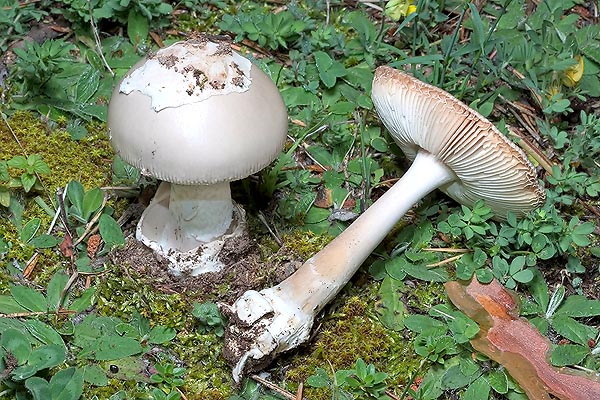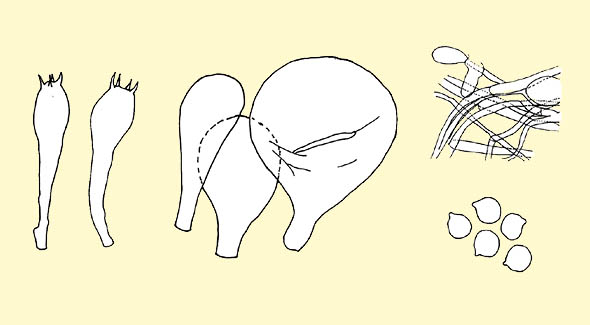
Text © Loredana Battisti

English translation by Mario Beltramini

Grey cap with central umbo and striated margin. Good edible, after cooking © Giuseppe Mazza
Family: Amanitaceae Roze.
Genus: Amanita Persoon.
Subgenus: Amanita Singer.
Section: Vaginatae (Fr.) Quélet.
Amanita vaginata (Bulliard) Lamarck 1784.
The name vaginata comes from the Latin “vaginatus” = protected by a sheath, due to the type of sheathing volva.
The Section Vaginatae (ex Amanitopsis = amanitas without ring), is characterized by basidiomata with prevailingly filamentous hyphal structure, composed by extended cells, so that the general or universal veil which protects them during the first growth stage (primary), while tearing, persists almost integrally at the base of the stem, with the form of a volva defined as sac-shaped, more or less wrapping, leaving on the surface of the cap some patches of variable size. They show the margin of the cap clearly striated , “combed”, and absence of partial veil, since it forms only at embryonic stage, to dissolve, later on, in thin flakes or stripes, which decorate the stipe. We find amanitas all edible after cooking, as they contain toxic, but thermolabile, substances (the hemolysins), which dissolve with temperatures of 70-80 °C.
Cap: of average size, from 6-10 cm, not much fleshy, frail, initially campanulate, then flattened, with central umbo surrounded by a light depression, with margin clearly striated, ash-grey colouring, with remains or white patches, more or less great.
Hymenophore: lamellae not much thick, free to the stipe, intercalated with truncate, white, lamellulae, fully sharp, concolorous. Spore print white.
Stipe: 10-15 x 1-2 cm, cylindrical, slender, fistulous, attenuated at the apex, and little enlarged at the base, covered by thin, concolorous, flakes. Ring absent. Sac shaped volva, tall and membranous, sheathing.
Flesh: tender, white, persistent. Odour and taste not distinctive. Not unpleasant.

Amanita vaginata: basidia, margin cells, volva and spores elements © Pierluigi Angeli
Chemical reactions: non-amyloid spores in contact with Melzer’s reagent.
Habitat: ubiquitous, spring, summer and early autumn, both in latifolious woods and in the conifers ones. Rather common species.
Edibility: good edible, after cooking.
Notes: easily identified species due to the colour of the grey cap, with clearly striated margin, stem without decorations, generally white veil.
Varieties of the species, based on the colour of the cap:
Amanita vaginata var. alba (De Seynes) Gillet, same as the type, but wholly white.
Amanita vaginata var. alutaceovergens Contu, has white cap, then pale yellow, tinted of grey, starting from the centre.
Amanita vaginata for. avellanea Traverso, has the cap of nut-brown beige colour.
Amanita vaginata var. argentata Contu, has silver grey cap.
Amanita vaginata var. plumbea (Schaeffer) Quelet & Bataille, with the cap of dark grey, plumb-grey colour.
Amanita vaginata var. cinerea (De Seynes) Gillet, has the stipe and the gills of a grey colour.
Amanita vaginata var. badia (Schaeffer) Quelet & Bataille, with a bay-brown, nut-brown, cap.
Remarks: the stripes on the cap, the absence of ring, and the stem never bulbous, are the main characteristics which differentiate it from the deadly amanitas: Amanita phalloides, Amanita virosa, Amanita verna.
→ For general notions about Fungi please click here.
→ To appreciate the biodiversity of MUSHROOMS please click here.
